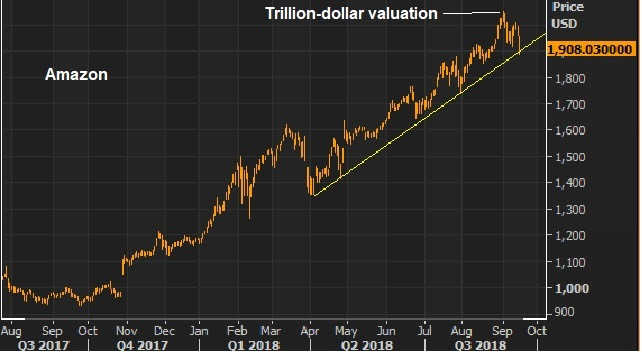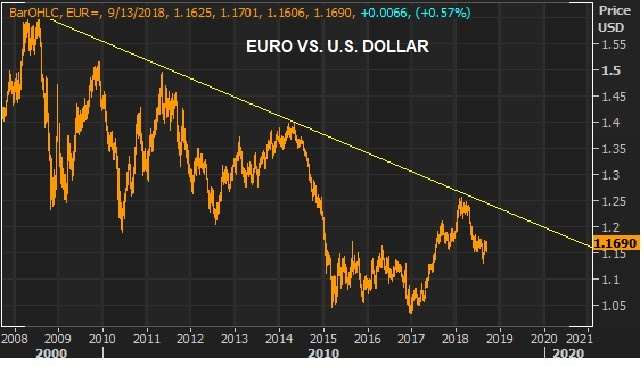September 19, 5:00 pm EST
Just two weeks ago, the Nasdaq was up 19% on the year, while the “blue-chip” heavy DJIA was up just 4%.
This is in a world where rates are low, corporate profits are growing at 20% and the economy is on pace to have above trend growth.
Great traders love when prices are detached from fundamentals, especially when it’s driven by fear or euphoria. This was a clear disconnect. And you could argue that there has been a bit of both fear and euphoria driving it (fear priced into the Dow about trade wars, and euphoria priced into the tech giants on the idea that the burgeoning monopolies would go unchecked forever until all competition is left for dead).
Both the fear and the euphoria were misguided for all of the reasons we discuss almost daily in my Pro Perspectives note.
And now we’re seeing a convergence. In just two weeks, that performance gap between the Dow and Nasdaq has now closed from fifteen percentage points to nine percentage points. And the Dow still has a lot of room to run. It remains just under the highs from January.
Now, yesterday we talked about the opportunity for Japan to benefit from forced trade reform in China. Other big beneficiaries? Emerging market economies.
In short, all of the countries that have been short-changed on their global trade competitiveness because of China’s weak currency policies, should benefit in a world where China is held to a standard of fair trade.
That’s why Japanese stocks had a huge run yesterday (and expect it to continue). And that’s why EM stock markets were big movers today. The Frontier Markets ETF (FM) is still down 14% on the year. With the idea that these countries may get a better crack at global demand, I suspect these stock markets could be in for a big bounce.
If you haven’t joined the
Billionaire’s Portfolio, where you can look over my shoulder and follow my hand selected 20-stock portfolio of the best billionaire owned and influenced stocks, you can
join me here.
September 18, 5:00 pm EST
Yesterday Trump made good on his promise by announcing another $200 billion in tariffs on China.
To the surprise of many, stocks went up. Why?
Perhaps it’s because reforming the way the world deals with China is a good thing. Remember, China’s currency manipulation over the past two decades led to the credit bubble, which ultimately led to the financial crisis. And as long as the rest of the world continues to allow China to maintain a trade advantage (dictated by their currency manipulation): 1) they will manufacture hot economic growth through exports, 2) the global cycle of booms and bust will continue, and 3) the wealth transfer from the rest of the world to China will continue.
With this in mind, as I’ve said, the trade dispute is all about China – everything else Trump has taken on (Canada, Mexico, Europe) has been to gain leverage on getting movement in China.
With Trump now making it very clear that he won’t back down until major structural change takes place in China, it’s no surprise that one of the biggest winners of the day (following the further economic sanctions on China) was Japan!
The Nikkei was up big today. And it was Japanese stocks that set the tone for global markets on the day. As a signal that China’s days of cornering the world’s export markets may be coming to an end, Japan is in position to be a big winner.
Remember, while much of the world has returned to new record highs following the global financial crisis, Japan remains 40% away from the record highs set nearly 30 years ago.
If you haven’t joined the Billionaire’s Portfolio, where you can look over my shoulder and follow my hand selected 20-stock portfolio of the best billionaire owned and influenced stocks, you can join me here.
September 5, 5:00 pm EST
Yesterday we talked about the case for breaking up Amazon, on the day it crossed the trillion-dollar valuation threshold. Today the stock was down 2%.
Also today, Facebook and Twitter executives visited Capitol Hill for a Congressional grilling.
If you listened to Zuckerberg’s Congressional testimony in April, and today’s grilling of Jack Dorsey (Twitter) and Sheryl Sandberg (Facebook), it’s clear that they have created monsters that they can’t manage. These tech giants have gotten too big, too powerful, and too dangerous to the economy (and society).
All have emerged and dominated, thanks in large part to regulatory advantage – operating under the guise of an “internet business.” And it all went unchecked for too long. These are monopolies in the making. But, as we know, Trump is on it.
As we discussed yesterday, Amazon has to, and will be, broken up. As for Facebook, Google, Twitter, Uber: the regulatory screws are tightening. Those businesses won’t look the same when it’s over. But it’s complicated. The higher the cost of compliance, the smaller the chances that there will ever be another Facebook or challenger. That goes for many of the tech giants.
With that in mind, regulation actually strengthens the moat for these companies.
That would argue that they may ultimately go the way of public utilities (in the case of Facebook, Google and Twitter).
If you haven’t joined the Billionaire’s Portfolio, where you can look over my shoulder and follow my hand selected 20-stock portfolio of the best billionaire owned and influenced stocks, you can join me here.
September 4, 5:00 pm EST
Today, Amazon became the second company (following Apple) to cross the one trillion-dollar valuation threshold.
This stock is up 72% year-to-date. It has doubled in the past year and has nearly tripled since Trump’s election. That’s what happens when you have a pour gasoline (economic growth) on a fire (a monopoly). No one should love Trump more than Jeff Bezos.
But at 161 times earnings, the market seems to be betting on the Amazon monopoly being left to corner all of the world’s industries. That’s a bad bet.
Much like China undercut the competition on price and cornered the world’s export market, Amazon has undercut the retail industry on price, and cornered the world’s retail business. That tipping point (on retail) has well passed. And as sales growth accelerates for Amazon, so does the speed at which competition is being destroyed. But Amazon is now moving aggressively into almost every industry. This company has to be/will be broken up.
The question is, how will the market value an ecommerce business that would no longer be subsidized by the high margin Amazon cloud business (AWS)? A separation of the businesses would put Amazon’s ecommerce margins under the Wall Street microscope (as every other retailer is subjected to) and materially impact a key sales growth driver for Amazon, which is investment in innovation (R&D).
If you haven’t joined the Billionaire’s Portfolio, where you can look over my shoulder and follow my hand selected 20-stock portfolio of the best billionaire owned and influenced stocks, you can join me here.
Nasdaq:AMZN, Nasdaq:AAPL, Nasdaq:FB, Nasdaq:GOOG












